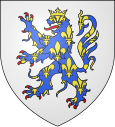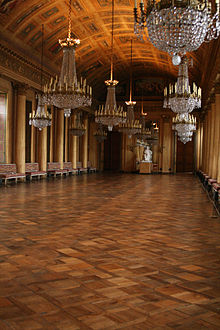Compiègne
| Compiègne | ||
|---|---|---|

|
|
|
| region | Hauts-de-France | |
| Department | Oise | |
| Arrondissement | Compiègne | |
| Canton |
Compiègne-1 (main town) Compiègne-2 (main town) |
|
| Community association | Région de Compiègne et de la Basse Automne | |
| Coordinates | 49 ° 25 ′ N , 2 ° 49 ′ E | |
| height | 31-134 m | |
| surface | 53.10 km 2 | |
| Residents | 40.199 (January 1, 2017) | |
| Population density | 757 inhabitants / km 2 | |
| Post Code | 60200 | |
| INSEE code | 60159 | |
| Website | www.mairie-compiegne.fr | |
 Compiègne Town Hall |
||
Compiègne [ kɔ̃ˈpjɛɲ ] is a northern French city with 40,199 inhabitants (as of January 1, 2017). It is the sub-prefecture of the same name arrondissement in the department of Oise in the region of Hauts-de-France .
geography
The place is 80 kilometers north of Paris at the confluence of the Aisne in the Oise .
history
Even the Merovingian built in Compiegne a Palatinate named Compendium . Chlothar II. Had to agree to the Peace of Compiègne in 603 after defeats against Theudebert II. And his brother Theuderich II . The great-great-grandson of Chlothar II, Chilperich II (670–721), chose the Palatinate as his residence. Charles the Bald expanded the city in 876 and named it Carolopolis . In 833 Ludwig the Pious was deposed here at the instigation of his eldest son Lothar and had to do church penance in public . The Carolingian kings Ludwig II, the Stammler (846–879) and Ludwig V, the Lazy (966–987) are buried in the church of Saint-Corneille .
On May 21, 1358 the peasant uprising of the Grande Jacquerie began in Compiègne and spread to northeastern France.
In 1380 King Charles V had a fortress built. On May 23, 1430, the Maid of Orléans fell into the hands of the Burgundians in front of the walls of Compiègne and was handed over to the English.
In the Compiègne Treaty of April 30, 1635, after the heavy defeat of the Swedes at Nördlingen , France and Sweden agreed on their further interests regarding the Thirty Years' War in the German Empire. In August 1635 an Imperial Spanish army reached the city with the intention of attacking Paris. This led to such great unrest and revolts against Richelieu in the population of Paris that King Louis XIII. himself was forced to visit his troops personally to calm the situation. The planned attack by the Spanish imperial troops from the north on Paris was canceled because the attack by another imperial army from the south, which was planned at the same time, was unsuccessful.
Between 1751 and 1788 it was built by Ange-Jacques Gabriel and later by his pupil Louis Le Dreux de la Châtre for King Louis XV. a new castle in the style of classicism . Napoleon Bonaparte and Napoleon III. had the castle renovated and expanded. Along with the palaces of Versailles and Fontainebleau, it is one of the three most important royal and imperial residences in France. Emperor Napoleon III. often used the castle as an autumn residence. On March 17, 1917, at 6 a.m., the German naval airship L 39 was shot down while burning over the city center. The 17 men of the crew died. In Compiègne there was a large military hospital and from April 1917 to March 1918 the great headquarters of the French army .
Compiègne is known for the signing of two armistices between Germany and France in the clearing of Rethondes , also known as the clearing of Compiègne:
- On November 11, 1918, in the Compiègne forest, the first Compiègne armistice , which ended the First World War , was signed in a railway carriage . Participants: the French Marshal Ferdinand Foch and the German politician Matthias Erzberger .
- Almost 22 years later on June 22, 1940, the second Compiègne armistice was signed between the German Empire and France . Those involved were Generals Wilhelm Keitel on the German side and Charles Huntziger on the French side. For the occasion, the Germans had the Compiègne car taken from the museum and had the contract signed in it.
Later, under the National Socialists in Compiègne, a transit and internment camp was set up in Royallieu (from June 1941 to August 1944). Politically controversial at that time was collaboration of Vichyregimes with the occupying power. The first train with political prisoners left Royallieu on July 6, 1942 in the direction of the Auschwitz extermination camp .
Worth seeing
Théâtre Impérial
Napoleon III had a theater built by Auguste-Gabriel Ancelet from 1866 on in place of the Carmelite convent destroyed during the revolution . With the end of the German Empire in 1870, however, work was stopped before the theater could be opened. The theater has been gradually renovated since 1987 and finally opened in 1991. The theater is the seat of the Théâtre Français de la Musique , which attracts an international audience mainly through the performances of rarely performed French operas and operettas.
Compiègne Castle
Louis Le Dreux de la Châtre, student and later collaborator of Ange-Jacques Gabriel , built this neo-classical palace between 1751 and 1788. Along with the palaces of Versailles and Fontainebleau, it is one of the three most important royal and imperial residences in France and is the largest of its architectural style in the country .
Emperor Napoléon lived here and received his future wife on March 23, 1810 in France. The palace was renovated and refurbished by the architects Berthault , Percier and Fontaine , the painter Girodet and the decorators Dubois and Redouté .
Compiègne later became the preferred residence of Napoleon III. He also used the large hunting ground.
In 1870 it was converted into a museum after the end of the German Empire . Today it houses three collections: Les appartements historiques with the rooms Napoleon III, Empress Eugénie , Napoleon Franz Bonaparte and others, Les musées du Second Empire about the Second Empire with a focus on the life of Eugénie and the Musée national de, established in 1927 in the former kitchen wing la voiture et du tourisme with an excellent collection of carriages and early automobiles.
A large, publicly accessible landscape park is attached to the castle .
Jakobskirche
The Saint-Jacques church was originally one of two parish churches in the city. The building from the 12th century has in its figurative decoration many references to his patron saint, the apostle James , and pilgrims tradition of the Pilgrim's Way to Santiago de Compostela on. The church tower from the 15th century was raised in the 17th century, in its upper area the statues of 14 saints were placed. Its role as a royal church in the immediate vicinity of the castle caused extensive renovations in the 18th century and lavish furnishings. Since 1998 the church has been listed as part of the UNESCO World Heritage “Camino de Santiago in France”.
Compiègne forest with the clearing of Rethondes
The 140 km² forest of Compiègne (French Forêt de Compiègne ) is located in the northeast of the city.
The clearing of Rethondes , where the armistice were signed in 1918 before Marshal Foch and in 1940 before Hitler , is called Clairière de l'Armistice in French and is located about 6 km east of Compiègne (albeit on its territory) south of the small village of Francport between its bridge over the Aisne and the N 31 ( Lage → ). In French , both armistices are called Armistice de Rethondes , after the village of Rethondes three kilometers to the east .
In this clearing, next to a memorial to Marshal Foch and a memorial to the German defeat under the Entente in 1918 (a sword that smashes the German eagle), there is a saloon car of the French train from 1918. Opposite the Foch memorial has been growing since 1994 as a sign of solidarity Germany and France an oak from the forest of Crawinkel .
The carriage of the train in which the armistice was signed was brought to Berlin as spoils of war in 1940 and later relocated to Crawinkel in Thuringia , where it was destroyed in the last days of the war. However, some individual parts of the wagon were preserved and given to the Compiègne Memorial. You can see another, identical series model of the saloon car, which was also on site at the events of 1918 and was used by the Allied delegation.
traffic
All bus routes in Compiègne can be used free of charge. Among other things, there are direct train lines to Paris to the Gare du Nord .
Colleges
- Université de Technologie de Compiègne (UTC) - Technical University
- École Supérieure de Commerce de Compiègne (ESC Compiègne) - business school
- École des Soins Infirmiers de Compiègne (ESI Compiègne) - Nursing school
Sports
The Paris – Roubaix cycling classic has been taking place in Compiègne every year since 1977 . USCCO soccer players have been in the French premier league for several seasons in the early 21st century .
Town twinning
Compiègne is twinned with the following cities:
|
|
Compiègne is also a member of the Federation of European Napoleonic Cities .
sons and daughters of the town
- Pierre d'Ailly (1350 / 51–1420), theologian and cardinal
- Christophe Capelle (* 1967), racing cyclist
- Patrice Carvalho (* 1952), politician
- François Chatriot (* 1952), rally driver
- Martyrs of Compiègne , the Sisters of Carmel executed in the French Revolution
- Maxime Godart (* 1999), actor
- Paul Helbronner (1871–1938), alpinist and geodesist
- Pascal Lalo (* 1969), actor
- Suzanne Lenglen (1899–1938), tennis player
- Thierry Madiot (* 1963), jazz musician
- Albert Robida (1848–1926), writer and caricaturist
- Nolan Roux (* 1988), football player
- Marco da Silva (* 1992), football player
Individual evidence
- ↑ Compiègne . In: Meyers Konversations-Lexikon . 4th edition. Volume 4, Verlag des Bibliographisches Institut, Leipzig / Vienna 1885–1892, p. 232.
- ^ C. V Wedgwood: The Thirty Years War. Paul List Publishers Munich (1967); ISBN 3-517-09017-4 (p. 355)
- ↑ a b c Homepage Schloss Compiègne: Un palais, trois musées , accessed on February 6, 2015.
- ^ Florence Evin: Compiègne, nid d'amour de Napoléon Ier. In: Le Monde . July 3, 2010, archived from the original on July 8, 2010 ; accessed on May 2, 2018 (French).
- ↑ Features. Compiègne. In: Neue Freie Presse , Morgenblatt, No. 19331/1918, June 20, 1918, p. 1 ff. (Online at ANNO ). .
- ↑ Secret trip to the Fourth Reich ( memento of the original from October 18, 2016 in the Internet Archive ) Info: The archive link was inserted automatically and has not yet been checked. Please check the original and archive link according to the instructions and then remove this notice. , Table of contents on heinrich-jung-verlag.de, accessed on January 30, 2013
- ^ Official website of Compiegne
Web links
- City of Compiègne
- Mémorial de l'internement et de la déportation. Le Camp de Royallieu. Royallieu Concentration Camp Memorial
- WHC Nomination Documentation (PDF; 91.1 MB), application documents for the nomination as World Heritage, here: section "Compiègne, Eglise paroissiale Saint-Jacques"







